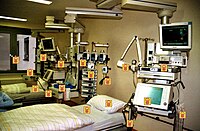
Photo from wikipedia
Although infections in patients with acute ST-segment elevation myocardial infarction (STEMI) are uncommon, with a reported rate of 2.4%, it is significantly associated with worse clinical outcomes. However, there is… Click to show full abstract
Although infections in patients with acute ST-segment elevation myocardial infarction (STEMI) are uncommon, with a reported rate of 2.4%, it is significantly associated with worse clinical outcomes. However, there is little published data on the prediction of infection in such patients. The age, creatinine and left ventricular ejection fraction (LVEF) score (ACEF score) is a simple risk assessment tool that was initially proposed in patients treated with elective cardiac surgery and validated in patients undergoing percutaneous coronary intervention (PCI). Moreover, the variables in this score may be related to infection. However, the predictive value of the ACEF score for infection in STEMI patients undergoing PCI has not been proved previously. Thus, the present study aims to assess the predictive value of the ACEF score for infection in such patients. We included 2085 patients who were diagnosed with STEMI and had undergone PCI from January 2010 to June 2016. The exclusion criteria were tumours or chronic inflammatory diseases, transplant recipients and patients on haemodialysis at admission. We also excluded patients undergoing emergency cardiac surgery or patients who died within 24 hours after admission. The ACEF score was calculated according to the following formula: ACEF1⁄4 age/LVEFþ 1 (if the serum creatinine (sCr) level was> 2mg/dL). Moreover, the age, estimated glomerular filtration rate (eGFR) and LVEF (AGEF) score was calculated according to the original definition: age/LVEF (%)þ 1 (if the eGFR was< 60mL/min/1.73m). Patients were divided accordingly into the following groups according to their ACEF score: a low-risk group (ACEF score< 1.04), an intermediate risk group (ACEF score 1.04 and< 1.40), and a high-risk group (ACEF score 1.40). The primary endpoint was infection. Infection during hospital admission was diagnosed according to the presence of signs and symptoms compatible with infection, and appropriate antibiotics were used once infection was confirmed. The secondary endpoints were inhospital major adverse clinical events (MACE) defined as a combined endpoint of all-cause death, stroke or any bleeding during the hospitalisation; and a composite endpoint of all-cause death or stroke during follow-up. The mean age (n1⁄4 2085, 19.0% men) was 62.3 years. There were 695, 692 and 698 patients in the low-risk, intermediate-risk and high-risk groups, respectively. The incidence of infection was 20.1% and increased across ACEF score groups (9.5%, 11.4%, 39.3%, P< 0.001). Similarly, the rate of MACE increased among the ACEF score groups (9.8%, 15.5% and
Journal Title: European Journal of Preventive Cardiology
Year Published: 2019
Link to full text (if available)
Share on Social Media: Sign Up to like & get
recommendations!